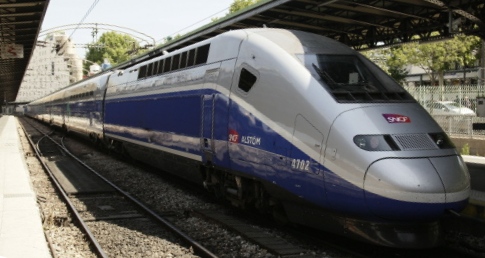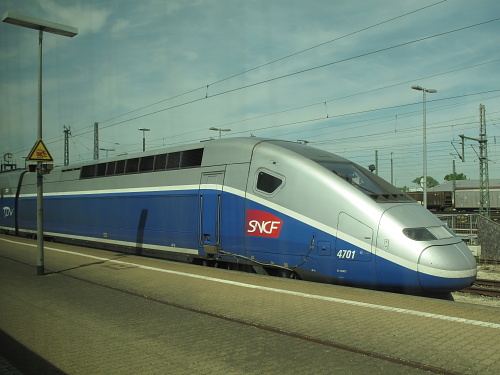Alstom übergibt TGV Duplex der 3. Generation an die SNCF
Alstom delivers its first 3rd generation Duplex TGV train set to SNCF
 Der TGV Duplex der 3.Generation. Foto: Alstom Transport / A.Février
Der TGV Duplex der 3.Generation. Foto: Alstom Transport / A.Février
[5. Juli 2011(Alstom)] Ende Mai hat Alstom die ersten Züge der dritten Generation des TGV Duplex symbolisch an SNCF-Präsident Guillaume Pepy übergeben. Diese Züge können erstmals freizügig auf den europäischen Netzen verkehren.
Von den im Juni 2007 bestellten 55 Zügen sind die ersten beiden Einheiten mit den Nummern 4701 und 4702 derzeit für Zulassungsfahrten unterwegs. Ab Dezember diesen Jahres sollen die ersten Züge auf der Hochgeschwindigkeitsstrecke Rhin-Rhône eingesetzt werden, bis 2014 soll die Flotte vollständig einsatzbereit sein.
Alstom delivers its first 3rd generation Duplex TGV train set to SNCF
On May 30, 2011, Alstom’s CEO Patrick Kron symbolically delivered to SNCF’s President Guillaume Pepy the first 3rd generation Duplex TGV train set. It is the first double-deck interoperable very high speed train capable of traveling on all European rail networks. SNCF had ordered a total of 55 train sets from Alstom in June 2007. Two of the train sets are currently undergoing final development and approval. Commercial operation is planned for late 2011. Among other routes, they will operate on the new Rhin-Rhône high-speed line scheduled to open in December 2011. The entire fleet will be delivered by 2014.
 Auf Zulassungsfahrt in Deutschland unterwegs: TGV Duplex Zug 4701.
Auf Zulassungsfahrt in Deutschland unterwegs: TGV Duplex Zug 4701.
Foto: Dierk Lawrenz
This event marks the introduction of a new generation of double decker railway equipment designed to meet new requirements in terms of interoperability, comfort, operations and total cost of ownership. The new trainsets, derived from previous generations of Duplex TGVs, take advantage of 30 years of experience in very high-speed railway equipment, which has resulted in a proven, safe architecture. The many shared components will help to reduce development, manufacturing, operating and especially maintenance costs.
The trains will run at up to 320 km/h on the railroad networks in France, Germany, Switzerland and Luxembourg. They feature signaling equipment compatible with all the aforementioned European networks and traction equipment suited to all currents encountered in Europe. Some of the trainsets will have modifications to allow them to travel in Spain; the Duplex TGVs sold in Morocco use the same platform.
In terms of comfort, emphasis has been put on passenger information systems. New external displays have been added near each train entrance, making it easier to read the train number, car number and destination. Screens within the cars are used to display the stations served and the final destination, along with information about the trip such as the time, geographical location and current speed of the train - all in several languages. Seats are now equipped with digital reservation displays to indicate the trip segments for which they are occupied. SNCF agents can also manage audio announcements from their control consoles and keep passengers informed during the trip. These messages are also displayed on the screens for the hearing impaired passengers. Accessibility has been optimized for persons with reduced mobility (PRM): more than 10% of the total train capacity (509 seats) is set aside for PRMs, including 50 specially outfitted seats. The areas for wheelchair users are larger (including the toilets), and wider aisles make it easier to move around.
Ground-to-train connection systems also offer new prospects for communication. For example, it is now possible to disseminate information about connections at the train's arrival station, update the seat occupancy map after the train's departure or alert the ground teams to a failure and anticipate its resolution. Passenger safety is another area in which the new trains have been improved. They have been designed to be equipped with video surveillance systems, and they also meet the strictest fire safety requirements. Fire doors are installed between and within cabins on trains that will be used in Spain, and fire detection systems have been added to new areas: toilets, nursery, baggage areas, electrical cabinets and machine compartments.
The 3rd generation Duplex TGV trainsets are designed and assembled on Alstom's sites: passenger cars in La Rochelle, locomotives in Belfort and extremity cars in Reichshoffen. Other Alstom sites help to manufacture the equipment: Ornans for the traction motors, Le Creusot for the trucks, Tarbes for the electrical blocks and traction equipment, Villeurbanne for the control electronics, Montréal for the passenger information systems Charleroi for the auxiliary inverters. Every day, a total of 1,500 people go to work on these sites to serve high-speed rail. The main French suppliers on the project are Faiveley Transport, Alstom GRID, Logitrade, COMECA, CEIT, TFCM and Association Bretagne Atelier. Together with the other small and medium sized industries in the French railway sector, they employ 6,000 people in France.


